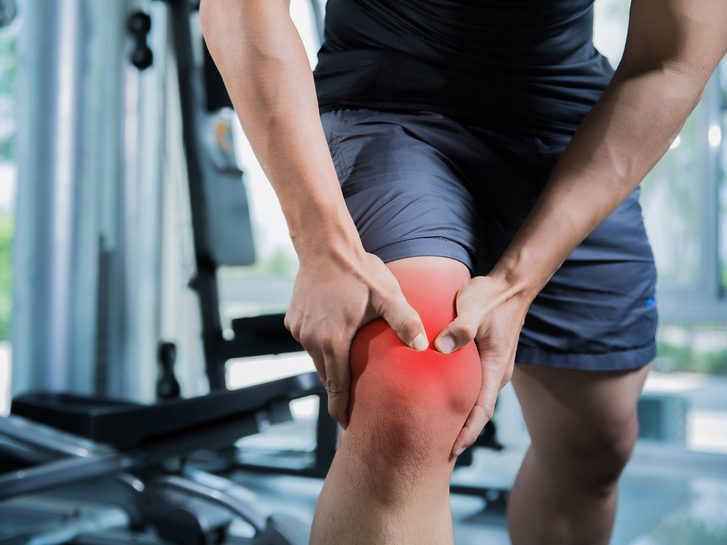
Could This Be the Culprit Behind Your Swollen Knee? Here’s What to Do About It

The knee is the largest joint in your body, which means it is the most susceptible to injuries and swelling that can be caused by a number of factors. The medical term for knee swelling is edema, and its most common symptom is severe pain that can make walking difficult, or worse, impossible.
The condition also affects the knee’s function and flexibility, hampering your daily activities, which can be irritating to say the least. So how do you address this? Before you poke your ballooning joint with a needle, it is best to understand the cause behind the problem.
Arthritis
Arthritis is basically an all-encompassing term for any inflammation of the joint. This is most common in the knee and has two kinds: osteoarthritis and rheumatoid arthritis.
In the latter, the immune system targets the joint and destroys the bones and tissues whereas the former, which is the more common, the cartilage, or the protective cap, of a joint wears away with time, the American Academy of Orthopaedic Surgeons said.
If you have this, you may feel stiff, swollen, or painful joints. Arthritis is also likely to develop as you age, which makes it even harder to move. According to MayoClinic, treatment varies on which type you have, but basically the aim is to reduce the symptoms for an improved quality of life.
Injuries

lzf/Shutterstock
Swelling of the knee as a result of an injury may be normal
That swollen knee may be a result of an injury – think hard, did you hurt yourself during your workout or perhaps bumped into a table? Believe it or not, the inflammation is just your body’s normal reaction to trauma and according to The Mount Sinai Health System chief of sports medicine James Gladstone, it is prevalent among younger patients.
As a result of the injury, the affected area gets an increased blood flow, prompting a rush of proteins, fluids, and white blood cells that begin the healing process – this explains why the spot becomes red and swollen the day after.
Gout or False Gout
Gout is a type of arthritis that develops when there are high levels of uric acid, a naturally occurring chemical in the body, that is a byproduct of purine breakdown, which result in the buildup of urate crystals in the joint.

TORWAISTUDIO/Shutterstock
Gout may wake you up in the middle of the night with excruciating pain in the knee
People who have this know how painful it is and how hard it is to go on with everyday activities with gout. This often occurs at the base of the big toe, but it can affect the knees, wrists, and other joints in the body.
Easy Orthopedics CEO Dan Paull explained that this usually occurs in extremities like hands, feet, and joints because of the cooler temperature these are exposed to which leads to the formation of crystals.
Calcium pyrophosphate dihydrate deposition or better known as pseudogout is also a type of arthritis but this one mostly affects the knees and wrists. The condition usually occurs when calcium crystals accumulate in the cartilage leading to fluid retention in the joints, which, like gout, brings about intense pain and swelling.
Lyme Disease

Ovidiu Hrubaru/Shutterstock
Bella Hadid has lyme disease which could be a culprit behind swollen knee
One reason to have your knee pain checked is that it could be a manifestation of a prolonged and untreated Lyme disease, which comes from a tick bite. Dr. James explained that whenever he couldn’t see a plausible cause for the swelling, he considers this the bacterial infection.
The Centers for Disease Control and Prevention said that knees are particularly prone to pain, arthritis, and inflammation that’s related to severe Lyme disease.
More in Health & Well-being
-
`
Home Safety: Keeping Bugs and Spiders Away From Your Home
Spiders may look a bit intimidating with their eight legs and beady eyes, but did you know that most of them...
December 27, 2023 -
`
Why Adults With ADHD Are 3x More Likely to Develop Dementia
We have all heard of ADHD, haven’t we? Hyper kids, distractions galore, restless minds – these are images we often associate...
December 11, 2023 -
`
Signs of Emotional Connection in Relationships
Building a strong connection with someone isn’t just about being in sync or sharing hobbies—it’s about that deeper bond, where you...
December 4, 2023 -
`
Hollywood’s Shortest Marriages: Britney Spears, Carmen Electra & More!
In the glitzy world of Hollywood, where fairy tales often unfold on the silver screen, there exists a flip side—a realm...
December 3, 2023 -
`
The Surprising Benefits of Unplugging
In today’s hyper-connected world, where we are constantly bombarded with notifications, messages, and the allure of social media, disconnecting may seem...
November 26, 2023 -
`
How “Looking Your Best” Improves Our Wellbeing
Most of us have had moments standing in front of our closet, deciding on an outfit for the day. And we...
November 15, 2023 -
`
Meet the Woman Who ALMOST Married Barack Obama
Barack Obama’s life has been a captivating narrative, often told and retold, with each revelation adding layers of intrigue to his...
November 5, 2023 -
`
The Rise of Caviar Bumps, Thanks to Gen Z
In an intriguing twist of culinary culture, millennials and Gen Zers are drawn to an unusual indulgence – fish eggs, or...
October 28, 2023 -
`
Everything You Need to Know About Acid Reflux, Heartburn and GERD
Ever had that burning-in-the-chest sensation after a meal? Or perhaps you have lain awake at night with an odd sour taste...
October 17, 2023















You must be logged in to post a comment Login